Struggling with low open rates and ineffective email campaigns? We’ve got you covered.
This article will teach you 13 effective ways to boost your email open rates and drive real results.
From crafting the perfect subject line and sending your email campaigns at the optimal time to writing effective preheaders, we’ll cover all the tactics that’ll guarantee your emails will get opened more often.
Get ready to take your email campaigns to the next level.
Here’s what we’ll explore:
- What is an email open rate
- What is the average email open rate
- 13 ways to increase email open rates
- Wrap-up and bonus tips
What is an email open rate?
Email open rate is a performance metric that indicates the percentage of email recipients that opened your email. To calculate the open rate, you need to divide the number of email opens by the number of delivered emails and multiply that ratio by 100.
Email open rate = (# of email opens / # of emails delivered) * 100%
It’s one of the most important metrics used by email marketers to measure their campaign’s reach. However, due to the introduction of Apple Mail Privacy Protection and an increase in email bot activities, it’s become less reliable. When analyzing your email campaigns, be sure to use a Bot Detection tool to make business decisions on human-only activities.
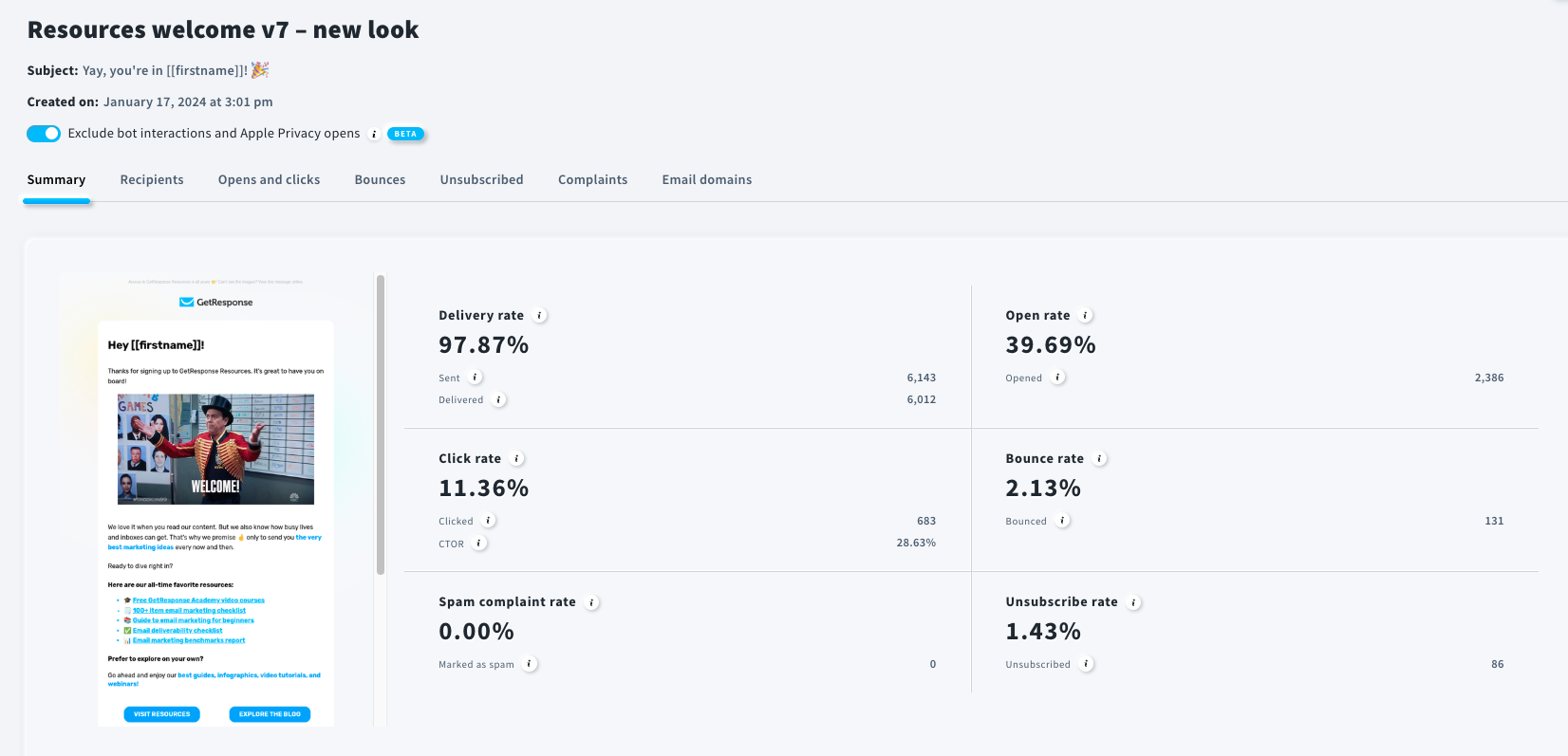
You get to know this metric because your email marketing software — like GetResponse — places a tiny, transparent image (a 1×1 tracking pixel) inside your message. When a subscriber opens the email and their client loads that image, your server registers it as an “open event.”
Note: Most email service providers insert the tracking pixel at the end of your message. If your email is too “heavy,” it might get truncated (clipped) by some mailbox providers — especially Gmail.
In Gmail, this happens when your email exceeds 102 KB in size. When that occurs, part of your content — including the tracking pixel — doesn’t load automatically. As a result, your reported open rate may drop, since the pixel only fires once subscribers click “View entire message.”
To avoid this, keep your email design lightweight. Optimize your images, trim unnecessary code, and always test your message size before sending.
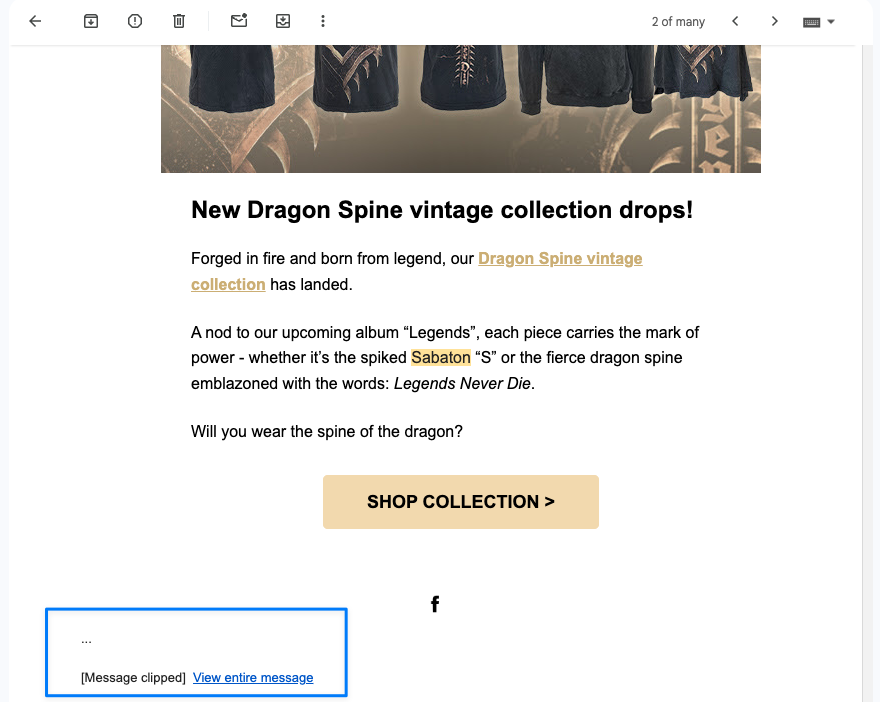
Related: Crucial Email KPIs to track your email campaigns’ performance
OK, but how can you figure out if you’re doing well or underperforming here?
What is the average email open rate?
Although there are email marketing players who are crushing it and impressing others with open rates above 50% (just see some of our case studies), the reality for the majority of email marketers isn’t that extreme.
According to our annual Email Marketing Benchmarks report, where we’ve analyzed 4.4 billion messages, we’ve found that the average global email open rate is 39.64%.
In reality, this number might be lower since the data had been collected before when we introduced the Bot Detector feature that lets you sift away non-human activities.
Having said this, it’s still a global average. Your open rate can be significantly higher or a bit lower when several factors come into play, such as:
- Location: if you’re in Europe, you can set an open rate benchmark at 43.25%, and if your business centers around North America, you can aspire to achieve an open rate close to 23.53%.
- Industry: you’re born under a lucky star, if your business is about Communications (65.14%) or Non-profits (54.54%)
- Business type: your subscribers can engage with your emails differently if you send them consumer content (B2C) or business-related (B2B).
- The type of email you send: is it a weekly newsletter, a webinar invitation, or a Black Friday deal? In each case, the numbers can go both ways.
13 ways to increase email open rates
Now that you know our email marketing statistics, it’s time to reinforce your know-how regarding effective email marketing campaigns that learn how to increase email open rate consistently.
1. Segment your audience
Segmenting your email list opens our list of best practices. And this is not a random shot. Understanding your audience — what drives them and what bothers them – is the key to every successful marketing program. And email marketing is no exception.
There are four basic segmentation categories you can take into account:
- Demographic (useful if you’re in B2C): based on individual attributes such as geography, gender, education, or income.
- Firmographic (useful if you’re in B2B): based on company attributes such as industry, location, number of employees, or revenue.
- Psychographic (which works for both – B2B and B2C): based on values and aspirations.
- Behavioral (as above – perfect for B2B and B2B): based on users’ behavior, product usage, and purchase decisions.
The last type of segmentation is the most vital in terms of your email strategy. People who tend to engage with your marketing emails once a month would go to a different segment than your subscribers who open your every message.
Related reading: Email segmentation strategies and best practices
Behavioral segmentation examples & strategies
Learn how Submission Technology, a lead generation agency, achieves over 7% average click-through rates using segmentation to divide its audience by gender, subscription date, and engagement.
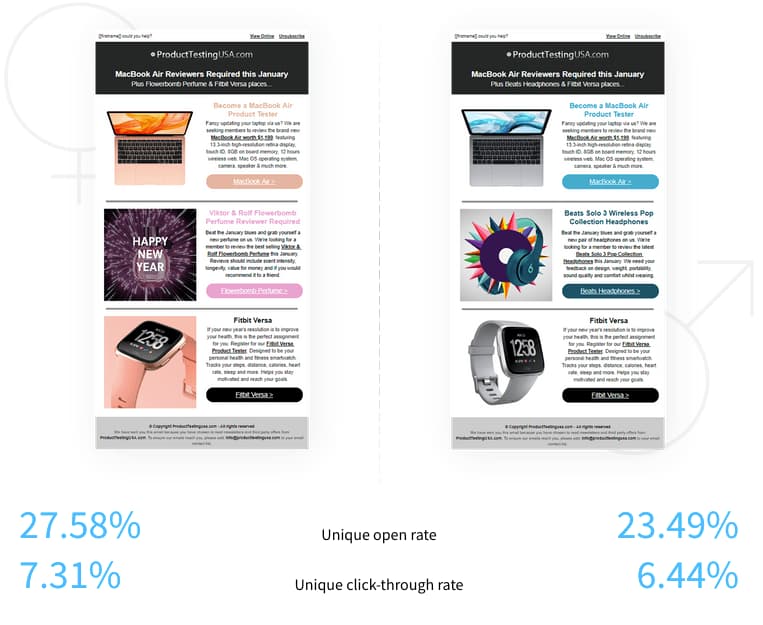
2. Deliver valuable content
This best practice comes as a result of proper customer research and segmentation. Once you know who your email subscribers are, you can increase email open rates by delivering content that will be precisely what they’re looking for.
While the tone of voice of your email content will depend on segment characteristics (not everyone will fall for emojis and humor), there are several aspects that will play a vital role in crafting your messages:
- Personalization – it’s not only about using your users’ first names and adjusting the wording to the buyer persona. It will also involve knowing where they’re at in the customer journey.
- Relevance – “Why the heck did I get this email? What does it have to do with me?” You wouldn’t like to make that kind of impression on your email subscribers. That’s why it’s essential to know what will matter for each segment and send relevant emails.
- Solving problems – whether you’re in B2B or B2C space, your role as a brand is to get rid of your customers’ headaches. Be explicit with naming their villain and highlighting the benefits of your product or services.
How often can you push your sales emails? Brian Dean from Backlinko suggests implementing an 80/20 rule. It works like this – 80% of your emails should provide value with no pitching, while the remaining 20% can push your sales offers, bundles, and upsells.
Pro tip: According to the latest Email Marketing Benchmarks report emails containing videos, images, or personalization in the email body continuously observe higher-than-average open rates.
3. Sharpen your email subject line
Writing enticing subject lines is often the first tip to improve email open rates — and for good reason. As a sender, you only have a few seconds to convince people to open your message. Considering your subscribers scan dozens of new emails daily, most will be ignored.
Remember, you’re not just competing with other newsletters or offers — you’re up against meeting reminders, project deadlines, and inbox fatigue.
Your goal is to craft subject lines that cut through the noise. Some experts say short subject lines perform best. Others swear by humor. The truth? What really matters is relevance and personalization.
There are several angles you can experiment with — making your subject lines:
- intriguing
- controversial
- humorous
- personal
- benefit-oriented
- special offer-oriented
But first, your subject lines must reflect your audience’s interests and pain points. Once you’ve nailed that, take things up a notch with personalized subject lines — for example, using your subscriber’s name, referencing their recent activity, or tailoring the message to their preferences.
Personalized subject lines make your emails feel less like campaigns and more like conversations — and that’s what drives opens.
You can also test adding emojis, numbers, or so-called “power words” to boost engagement.
If you’d like to go deeper into this topic, check out our guide to writing effective email subject lines. It breaks down ten proven strategies and offers plenty of real examples you can replicate for your own business.
💡 If you ever feel stuck or want a fresh burst of inspiration, try our AI Email Generator. It analyzes best-performing copy patterns and helps you craft compelling, click-worthy subject lines in seconds.
4. Double down on your preheaders
If you think of a subject line as the title of your email message, a preheader (also known as a preview text) will be your subtitle.
Preheaders are equally important in getting people to open and read emails. Even if your subject line is minimalistic and contains only three words (for instance, “Email Marketing Strategy”), you will have more space to plug something valuable and enticing in the preview text.
Here are some compelling examples:


Pay attention to how clean and straightforward the above subject lines are. And now imagine that there is no preview text right next to it. Would you click on the “Drop the Ego” email without an additional hint on what it is about? Probably not. But then comes the preheader nailing it with “shares what he wished for a profitable business.”
How do you set up a preview text before you start to send emails? In GetResponse email creator, it’s effortless:
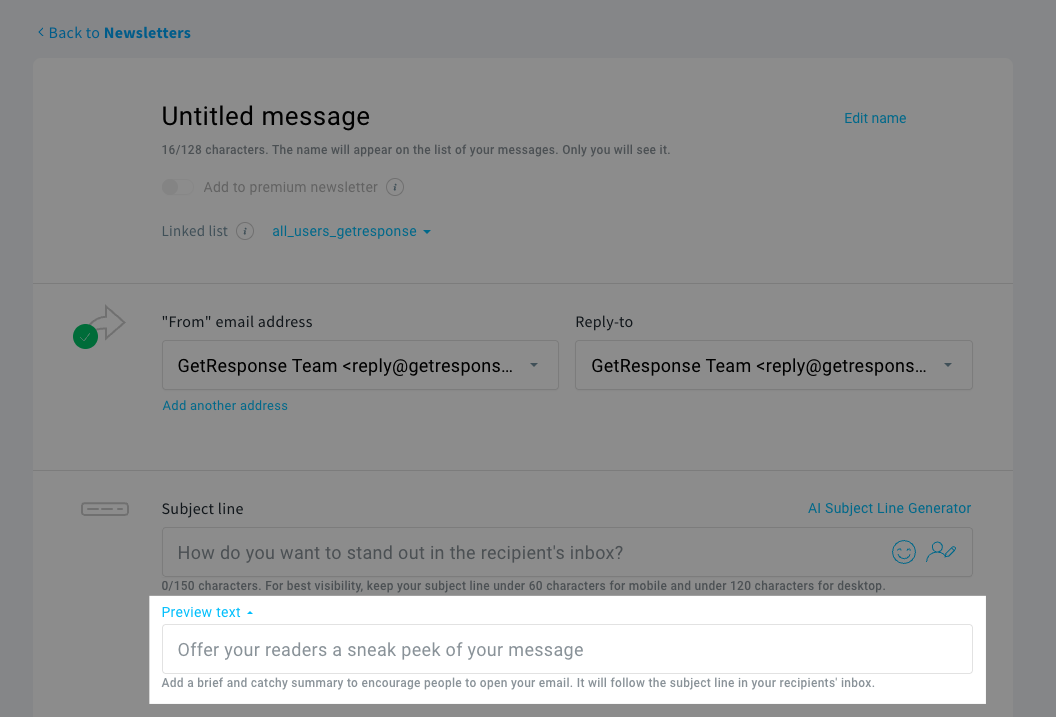
Note: If you don’t provide a preheader in your email’s settings, most mailbox providers will display the first line of your message instead. This can sometimes cause confusion or simply offer no value to your audience. If you want to have full control over your email campaigns, I suggest that you take the time to fill out this extra line of text.
![Example of a good preheader that builds upon the email subject line.
Subject line: [PIC] From zero to $4,500/month…
Preheader:... with just ONE CLIENT](https://us-wd.gr-cdn.com/blog/sites/5/2023/02/1052/good-preheader-example.jpg)
Pro tip: Our study also found that emails that include a preheader observe an average open rate of 44.67%, over 5 percentage points higher than the industry standard.
5. Work on your From Name
A sender name or a From Name is one of the three elements people see in their inbox before they even open your email. And while subject lines and preview texts are vital for drumming up email open rates, email marketers also highlight the meaning of the sender name:

Unless you’re an influencer with a recognizable name, I suggest trying out one of those approaches (or mixing them up):
- [Your first name] from [Your brand name] will help your brand show a human face. That a real person looks after your subscribers instead of a distant business organization. It will work like a charm, especially for giving valuable tips and solving problems for your customers. Here’s an example:

- [Your brand name] + Team – here, you won’t be putting a person in the spotlight, but you will point out that your company is a group of friendly folks that sync to help your customers. It usually works better with product announcements or special deals. An example of that approach:

6. Find the best time to send emails
Optimizing your send-out time is one of the critical factors for email opens. And at the same time, it’s still one of the most common aspects of email campaigns that businesses try to figure out.
There is no silver bullet that will guarantee that all emails sent at 8 AM each Monday will improve email engagement rate – always, for every industry, and everywhere. No, two many variables can influence the results.
However, according to the Email Marketing Benchmarks report, it turns out that the best time is to send emails very early in the morning (4 AM-5 AM), and after an office-time plateau, there’s another spike at 5 PM.
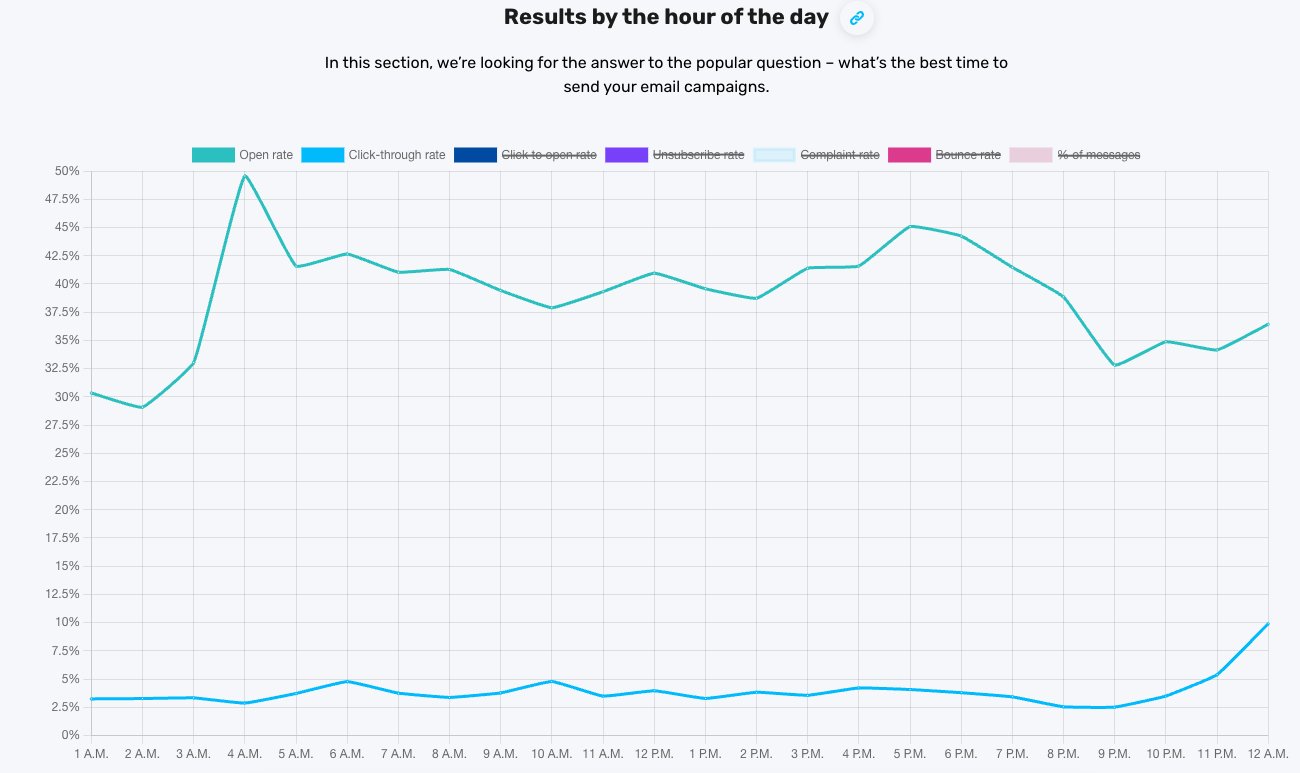
And what about the day of the week? The same data shows that it doesn’t matter which day you choose (as long as you stick to working days) because their differences are so tiny.
If you’re unsure which time will work the best for your audience, and you don’t have time to take chances, you can try out GetResponse’s Perfect Timing feature. It uses AI and behavioral data to optimize the send time to match each individual’s email subscriber needs.

7. Add your logo to your emails
What also drives people to open emails depends on how much they trust the sender. Do they recognize the brand? Do they associate the brand’s name with positive emotions?
If your brand goes in hand with authority, security, and fame, you can directly capitalize on that by embedding your logo into your emails.
And you can do it by authenticating your email domain with BIMI — Brand Indicators for Message Identification. There are two ways to handle it — with the help of your IT team (because it might get tricky) or by setting it up directly in a Google account (click here to get more details).
Is it worth a shot? Take a look at this picture:

8. Use Gmail annotations to stand out in the promotions tab
If a large portion of your audience uses Gmail (and chances are, they do), there’s a powerful yet underused feature you can tap into — Gmail Annotations.
Annotations let you add extra visual elements — like your brand logo, featured image, deal code, or expiration date — right inside the Promotions tab preview. Instead of competing with dozens of plain-text subject lines, your email suddenly becomes visually rich and clickable.
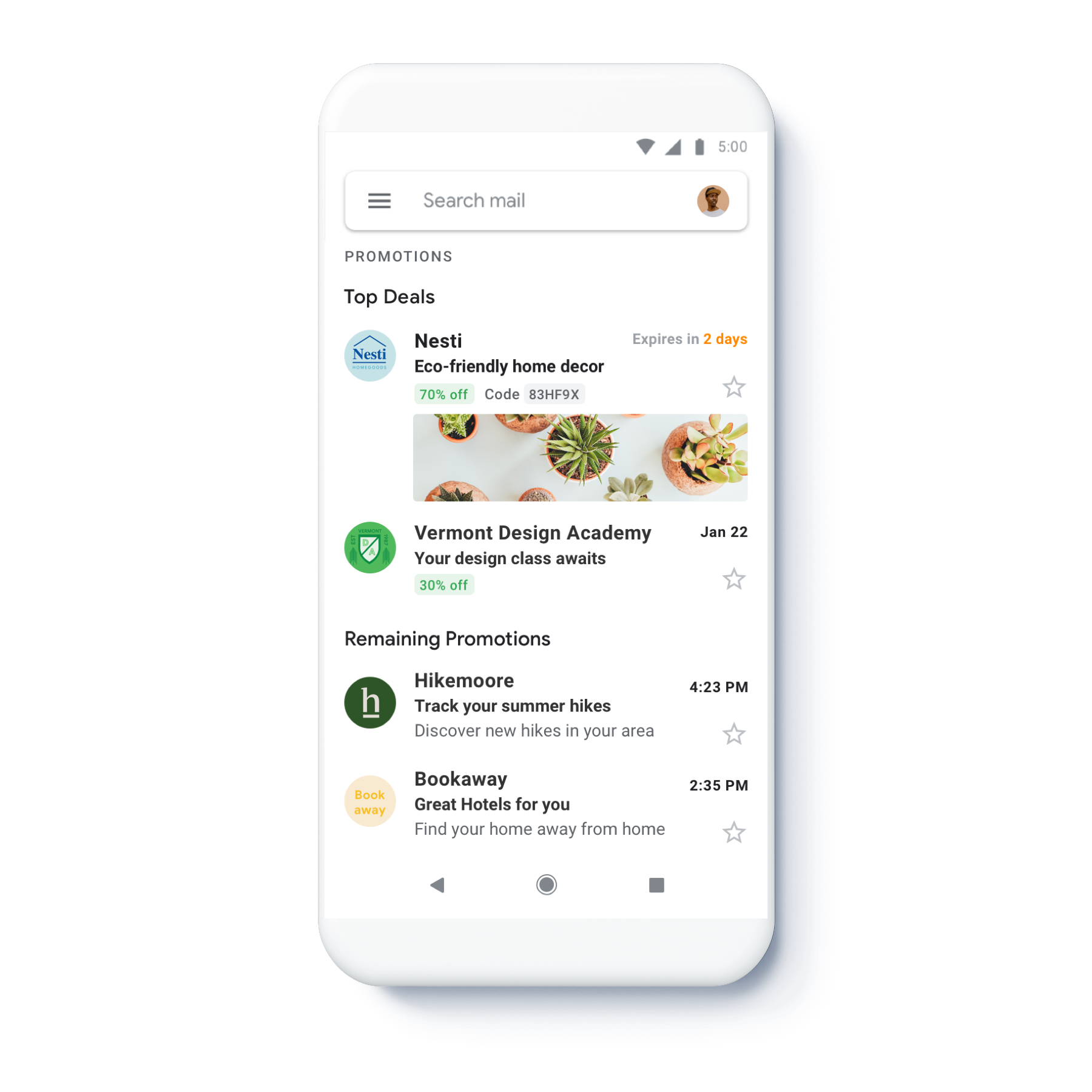
For example, imagine your Black Friday newsletter showing a bold “50% OFF – Ends Sunday” banner before the user even opens it. That’s exactly what annotations can do.
Setting them up is easier than it sounds — you just need to add a small snippet of markup to your email’s HTML. Here’s a step-by-step guide to using Gmail email annotations.
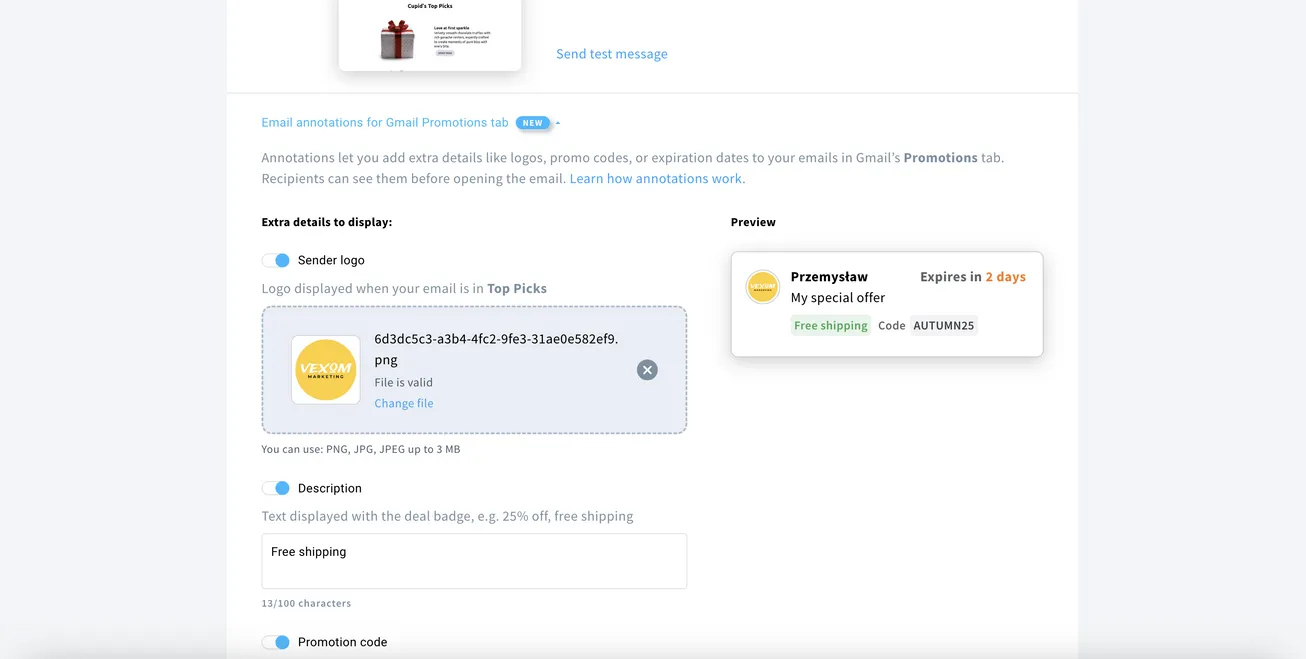
Used right, Gmail Annotations can boost your visibility, brand recognition, and open rates, all in one go.
9. Stay out of the spam folder
Unfortunately, with email spam filters becoming more advanced, some of your subscribers may never see your messages because they’re automatically categorized as spam.
How to avoid landing in the spam folder? Here’s what to focus on:
- Always get permission before sending emails. With stricter data regulations, you’re only allowed to contact people who’ve given explicit consent (for example, via double opt-in). Avoid shady shortcuts like buying email lists — they’ll hurt your deliverability and your sender reputation.
- Be transparent from the start. When users opt in, clearly state what kind of messages and offers they’ll receive. Reiterate it in your welcome email and mention how often you’ll write to them.
- Use a trustworthy email marketing platform. At GetResponse, we help protect your sender reputation by managing your IP reputation, processing bounces, handling complaints, unsubscribes, and collaborating with major ISPs and anti-spam organizations.
- Avoid using unverified or freemail domains (like Gmail or Yahoo!) for your campaigns. Sending from your own domain is a signal of legitimacy. If your domain is new, build up your domain and sender reputation gradually.
- Make it easy to unsubscribe. If someone wants to leave your list but can’t find the unsubscribe button, they might mark you as spam instead — a move that directly hurts your sender reputation.
- Craft honest, relevant subject lines. Avoid clickbait, misleading prefixes like “FWD:” or “Re:”, and all-caps shouting.
- Balance your email design. Spam filters look for messages overloaded with images and minimal text, or poorly coded layouts.
- Watch your sending frequency. Bombarding people with daily emails can cause fatigue, leading to lower engagement — another negative signal for ISPs monitoring your sender reputation.
Here you’ll find more guidelines on why emails end up in spam folders and how to avoid them.
Also, another aspect that influences both being marked as spam and improving open rates is your email list hygiene.
10. Keep your email list healthy
Different scenarios can affect your email deliverability and your sender’s reputation. People:
- give fake emails when they subscribe to email lists
- change their jobs (if they are using their professional account to opt in)
- abandon their old inboxes
That’s why you need to invest your time and keep your email list clean.
But your email list hygiene comes down to more than just verifying old emails (here you’ll find a complete list of email list cleaning best practices). It’s also about checking the engagement of your subscribers and taking action according to users’ behavior.
Based on their historic low or high engagement, you can use marketing automation to:
- cleanse your list through tags and scores
- win back non-engagers and remove those who ghost you

Your email list hygiene also calls for another tactic:
11. Resend your emails to dormant contacts
Even the most compelling subject line, fine-tuned preview text, and optimized send-out time won’t trigger most of your contacts to engage with your email. In fact, a big chunk will remain inactive no matter what happens.
But that’s OK. Life happens – work, lack of time, personal issues – so we all skip most newsletters. That’s why there’s nothing wrong with sending a followup.
When preparing re-engagement email campaigns, remember to:
- Not to do it too often, and only once per email
- Resend your email a day after the original one got delivered (potentially at a different time)
- Twist your subject line not to be the same as the original one
- Only resend meaningful emails, not just regular email newsletters
- Exclude people who’ve opened your first email or who’ve already converted on your offer
- Monitor your email deliverability regularly
12. Make your emails mobile-friendly
Your emails must work perfectly, not only for folks who open their inboxes on their laptops. Each email campaign has to be optimized for mobile users. The stakes are high, especially having your fresh subscribers in mind. Just imagine — they’ve opted in to your list recently, so they’re likely to open your first one and check your quality. If that happens to be on their mobile devices, and when it’s not responsive or slow to load, they will rather not open your emails in the future.
So make sure that you:
- Design your emails that will look good on any device – smartphone or tablet, which comes to responsiveness.
- Remember that large image files will take longer to load, so don’t test people’s patience and use smaller images.
- Use larger fonts and finger-friendly CTA buttons, and avoid placing links close to each other.
- Go for a simple and uncluttered structure. Make it easy to go through and take action wherever your subscribers open your message.
And if you don’t want to take chances in designing your email for mobile devices, try the GetResponse Email Creator, where every email template comes together with a mobile version:

👉 Learn more about email design best practices in our Email Design Guide.
13. A/B Test your email campaigns
Running A/B tests is one of the most exciting and efficient methods to achieve email marketing success. To remind you, A/B testing (also known as split testing) means evaluating two versions of a given element of your email. You can test many aspects of your email content (more about that in our comprehensive guide on A/B testing), but for the sake of increasing email open rates, we suggest you focus on testing subject lines and preview texts.
Once you add up to 5 different subject lines in GetResponse’s A/B testing tool, you can then set up how many recipients will receive each variant and the duration of testing:

Read more related content:
1. Email marketing tips for small businesses
Wrap-up + bonus tips
Alright! At this point, you know that to make your open rates go up, you need to master the following:
- Audience segmentation
- Valuable content
- Effective email subject lines
- Preheaders
- From name
- Email send time
- Using logos effectively
- Email annotations
- Avoiding email spam filters
- Keeping your email list healthy
- Resending emails
- Mobile email optimization
- A/B testing
But the list of email marketing tips doesn’t end here! What you can also put into action is:
- Making an outstanding first impression with a welcome email. If you do provide something special, you can plant a habit of engaging with your future emails.
- Experiment with those messages: myth-busting emails, “my number one mistake” emails, or actionable tips emails.
- And last – start implementing your strategy with a top email marketing platform. Try GetResponse for free!
